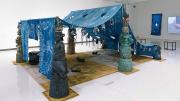A new installation at the Carpenter Center for Visual Arts looms like a scene from a speculative novel. Los Angeles-based artist Candice Lin created the indigo-fabric tent flanked by chimerical animal sculptures while relegated to her home studio during the pandemic. Throughout the rising infections and death, wildfires, and political upheavals, the components of Seeping, Rotting, Resting, Weeping came together as an otherworldly, animistic campsite reflecting both an ancient past and an unknowable future. The tent evokes a nomadic existence, and a makeshift temple. It reflects a desire for communal gathering, a tactile haven, but also vulnerability and the search for protection. The vision “came from an intuitive place,” Lin says during a talk recorded by the Carpenter Center, with “animal hybrid forms that have come out of my imagination since I was a child.”
She made these fanged, breasted, and crowned creatures, firing them in her home kiln, and says they also reference Zhenmushou (tomb guardians) from the Chinese Tang Dynasty, intended to ward off evil. Her drawings of felines, fantastical creatures, and geometric forms also appear on the tent panels, which can alternatively serve as dresses or cloaks, and on carpets dotted with ceramic cat “pillows.” Indigo fabric masks with string bindings hang from the tent’s edges like ragged prayer flags. Known for experiments with decomposing materials, Lin used traditional Japanese techniques to ferment indigo plants, and then hand-dyed and printed images on each tent panel. The depictions are also reminiscent of Nigerian adire textiles dating to early twentieth-century global trade and colonialism, a nod to the ways in which humans have dominated the earth and subordinated its creatures.
Gallery guests are invited to rest on the rugs or stand on paw-print marked spots outside the tent and follow along with a video of a cat demon in a desert demonstrating Chinese qigong. A man’s weirdly meditative voice-over instructs amid pop-up promotions, memes, and bot ads. In the end, the cat and its entourage disappear during an earthquake. The video “is a take-off on the wellness culture, and Tik Tok, and spam texts,” says Carpenter Robinson Family director Dan Byers, who co-curated the show (which opens with a gallery talk on February 4). “Lin signals the interface that many people during the pandemic used for socializing but does so in a very surreal way. It’s critical and a bit absurdist.”
While working on the installation, the artist’s closest companion was her cat, Roger. He appears in the video, too, along with White and Gray, a feral cat who lived on her porch for 11 years. Although felines abound in this installation, “It’s not a cat piece,” Lin asserts during the talk. She is reluctant to precisely pin down what the piece means, and how the layers of symbols and inter-species relationships at play should be understood, yet visitors might learn more reading through the handmade book she kept, A Journal of the Plague Year (Cat Demon Diary); it offers materials samples and notes on her process, along with harrowing drawings and tender personal reflections. Seeping, Rotting, Resting, Weeping, it seems, can be seen to encompass responses to a world suddenly tipped on its head, although the seeds of disruptions—commodification, human-driven environmental degradation—have long been known. “I am eager to use art to speculate and imagine new futures,” Lin wrote in an artist statement from 2016, “where power is distributed differently and the normativity of bodies collapses into a discrepant multitude, and edifices of authority are denaturalized and crumbling.” The tent is a refuge, a stake in the new and evolving future, where the categories visitors or curators use to define her work, or even use to delineate life forms, are moot, or at least blurred, in favor of a world, as she says, “without categories or distinctions of origins or of species.”








